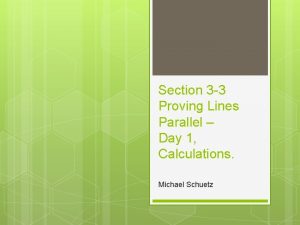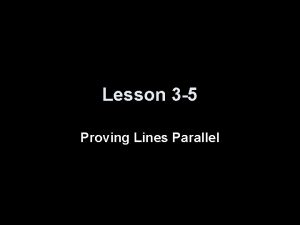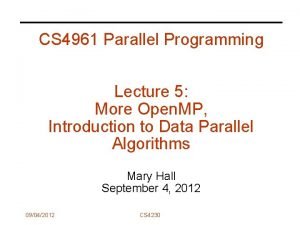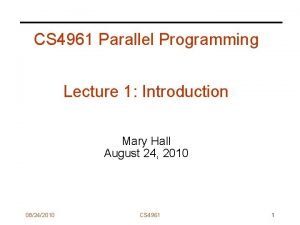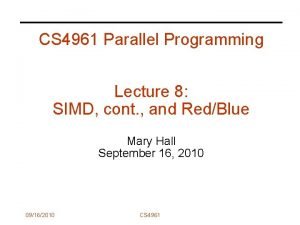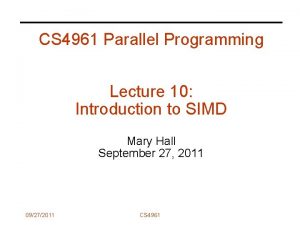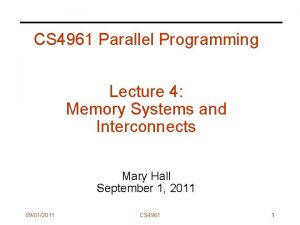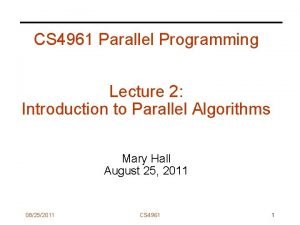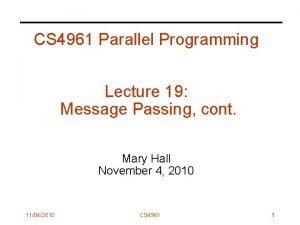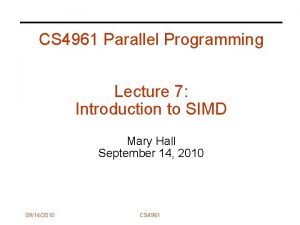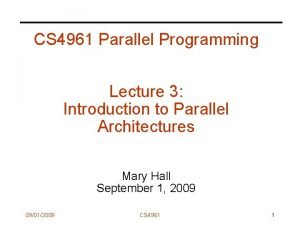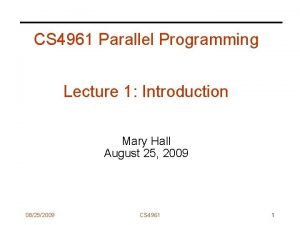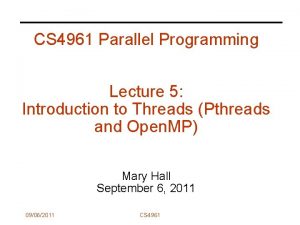CS 4961 Parallel Programming Lecture 15 LocalityVTUNE Homework












![Canonical Example: Selecting Loop Order for (i=0; i<N; i++) for (j=0; j<N; j++) C[i][j] Canonical Example: Selecting Loop Order for (i=0; i<N; i++) for (j=0; j<N; j++) C[i][j]](https://slidetodoc.com/presentation_image_h/1996597c1f7130f5cc3630f91ded56ec/image-13.jpg)

- Slides: 14

CS 4961 Parallel Programming Lecture 15: Locality/VTUNE Homework Mary Hall October 27, 2009 10/27/2009 CS 4961 1

Administrative • Homework assignment 3 will be posted today (after class) • Due, Thursday, November 5 before class - Use the “handin” program on the CADE machines - Use the following command: “handin cs 4961 hw 3 <gzipped tar file>” • Mailing list set up: cs 4961@list. eng. utah. edu • Next week we’ll start discussing final project - Optional CUDA or MPI programming assignment part of this 10/27/2009 CS 4961 2

Midterm Exam Score Range 10/27/2009 Number of Students Grade 97 -100 1 A+ 88 -93 6 A 85 -87 4 A- 80 -83 7 B+ 75 -79 7 B 72 -73 2 B- 59 -61 2 C CS 4961 3

Comments on Exam • Overall, most students did well with the concepts • Some problem-solving gaps • Quick discussion of questions 10/27/2009 CS 4961 4

Exam discussion Problem 2: a. A multiprocessor consists of 100 processors, each capable of a peak execution rate of 2 Gflops (i. e. , 2 billion floating point operations per second). What is the peak performance of the system as measured in Gflops for an application where 10% of the code is sequential and 90% is parallelizable? Key point: Speedup roughly 10, so roughly 20 GFlops 10/27/2009 CS 4961 5

Exam discussion b. Given the following code, which is representative of a Fast Fourier Transform: procedure FFT_like_pattern(A, n) { float *A; int n, m; Key points: main m = log 2 n; dependence on j loop, for (j=0; j<m; j++) { k = 2 j; parallelize I loop for (i=0; i<k; i++) A[i] = A[i] + A[i XOR 2 j]; } } (1) What are the data dependences on loops i and j? (2) Assume n = 16. Provide Open. MP or Peril-L code for the mapping to a shared-memory parallel architecture. 10/27/2009 CS 4961 6

Exam discussion (c) Construct a task-parallel (similar to producer-consumer) pipelined code to identify the set of prime numbers in the sequence of integers from 1 to n. A common sequential solution to this problem is the sieve of Erasthones. In this method, a series of all integers is generated starting from 2. The first number, 2, is prime and kept. All multiples of 2 are deleted because they cannot be prime. This process is repeated with each remaining number, up until but not beyond sqrt(n). A possible sequential implementation of this solution is as follows: for (i=2; i<=n; i++) { prime[i] = true; for (i=2; i<= sqrt(n); i++) { if (prime[i]) { for (j=i+i; j<=n; j = j+i) { // multiples of i are set to non-prime[j] = false; } } Key points: Task parallelism, buffer for queuing data so no data dependences, modify indexiing 10/27/2009 CS 4961 7

Homework 3 Problem 1. Assume a cache line size of 4 elements. Identify the different kinds of reuse and how many memory accesses there are in the following example, assuming (a) row-major order, (b) column-major order. Use the inner loop memory cost calculation from slides 11 -13 of Lecture 15 to estimate memory accesses. for (i = 0; i<n; i++) for (j = 0; j<m; j++) A[i][j] = B[i][j] + B[j][i] + C[i] 10/27/2009 CS 4961 8

Homework 3, cont. Problem 2. What code would be generated to tile the following loop nest for reuse in cache, assuming rowmajor order and two levels of tiling (Note: the loop order may need to be modified). Prove that tiling is safe. for (i = 0; i<n; i++) for (j = 0; j<m; j++) for (k=0; k<l; k++) A[i][k] = A[i][k] + B[k][j]*C[k][k] 10/27/2009 CS 4961 9

Homework 3 Problem 3: VTUNE: Consider the jacobi code in jacobi. c on the website. Here is the main computation: // play around with this loop nest for (i=1; i<width-1; i++) for (j=1; j<height-1; j++) A[i][j] = (B[i+1][j] + B[i-1][j] + B[i][j+1] + B[i][j-1])/4; (a) Run this code under VTUNE. Indicate event-based sampling, and collect the following events. (CPU_CLK_UNHALTED, MEM_LOAD_RETIRED. L 1 D_MISS, MEM_LOAD_RETIRED. L 2_MISS) (b) Now attempt to tile the innermost loop and repeat. Do you see an impact on cache misses and cycles. (c) Extra credit: Tile the other loop. Now what happens. 10/27/2009 CS 4961 10

Reuse Analysis: Use to Estimate Cache Misses Remember: Row-major storage for C arrays for (i=0; i<N; i++) for (j=0; j<M; j++) A[i]=A[i]+B[j][i] for (j=0; j<M; j++) for (i=0; i<N; i++) A[i]=A[i]+B[j][i] (*) cls = Cache Line Size (in elements) 10/01/2009 CS 4961 11

Allen & Kennedy: Innermost memory cost • Innermost memory cost: CM(Li) Implicit in this cost - assume Li is innermost loop function is - li = loop variable, N = number of iterations of Li that N is sufficiently - for each array reference r in loop nest: large that - r does not depend on li : cost (r) = 1 cache - r such that li strides over a non-contiguous dimension: capacity is cost (r) = N exceeded by - r such that li strides over a contiguous dimension: cost data (r) = N/cls footprint in innermost - At outer loops, loop - multiply cost(r) by trip count if reference varies with loop index - Otherwise, multiply cost(r) by 1 unless pushed out of cache - CM(Li) = sum of cost (r) 10/01/2009 CS 4961 12
![Canonical Example Selecting Loop Order for i0 iN i for j0 jN j Cij Canonical Example: Selecting Loop Order for (i=0; i<N; i++) for (j=0; j<N; j++) C[i][j]](https://slidetodoc.com/presentation_image_h/1996597c1f7130f5cc3630f91ded56ec/image-13.jpg)
Canonical Example: Selecting Loop Order for (i=0; i<N; i++) for (j=0; j<N; j++) C[i][j] = 0; for (k=0; k<N; k++) C[i][j]= C[i][j] + A[i][k] * B[k][j]; • CM(i) = 2 N 3 + N 2 [C: N 3, A: N 3, B: N 2) • CM(j) = 2 N 3/cls + N 2 [C: N 3/cls, A: N 2, B: N 3/cls] • CM(k) = N 2 + N 3/cls + N 3 [C: N 2, A: N 3/cls, B: N 3] • Ordering by innermost loop cost: j, k, i 10/01/2009 CS 4961 13

Canonical Example: Selecting Tile Size Choose Ti and Tk such that data footprint does not exceed cache capacity DO K = 1, N by TK DO I = 1, N by TI DO J = 1, N DO KK = K, min(KK+ TK, N) DO II = I, min(II+ TI, N) C(II, J)= C(II, J)+A(II, KK)*B(KK, J) BK BI C 10/01/2009 A CS 4961 B 14
 01:640:244 lecture notes - lecture 15: plat, idah, farad
01:640:244 lecture notes - lecture 15: plat, idah, farad Homework oh homework i hate you you stink
Homework oh homework i hate you you stink Homework oh homework i hate you you stink
Homework oh homework i hate you you stink Jack prelutsky homework oh homework
Jack prelutsky homework oh homework Homework oh homework i hate you you stink
Homework oh homework i hate you you stink Alitteration definition
Alitteration definition The zebras cried when the wise old elephant died
The zebras cried when the wise old elephant died C data types with examples
C data types with examples Cloud computing lecture
Cloud computing lecture Parallel and perpendicular lines unit 3
Parallel and perpendicular lines unit 3 Homework 3 proving lines parallel
Homework 3 proving lines parallel Lesson 3-5 proving lines parallel
Lesson 3-5 proving lines parallel Perbedaan linear programming dan integer programming
Perbedaan linear programming dan integer programming Greedy programming vs dynamic programming
Greedy programming vs dynamic programming System programming
System programming










